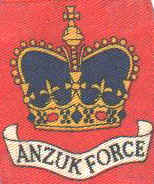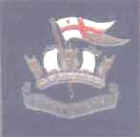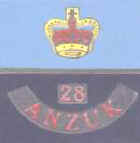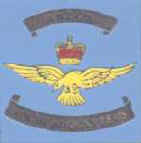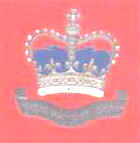|
"What was
ANZUK?"

ANZUK Force may not have been very large, but it was a complex
organization and underwent quite a few changes in its brief history. The
idea of ANZUK Force came from the politicians and the diplomats. The
British had maintained a presence in Singapore and Malaya for many
years, and with the coming of the Japanese during the Second World War
they were joined by Australian troops. After the world war another more
protracted war began—this time against the communist terrorists—and
British, Australian, and New Zealand servicemen joined together to fight
the CTs in the jungle.
At this time Britain was
committed to provide defence assistance to Malaysia and Singapore under
the Anglo-Malayan Defence Agreement of 1957 with which Australia and New
Zealand were associated. As the insurgency and the
"confrontation" between Indonesia and the newly formed Malaysian
State tapered off it was obvious that Britain would reduce the numbers of
troops stationed here. The British Parliamentary Labour Party began
talking about cuts in 1966, then, in July 1967, the Labour Government
announced substantial reductions. Of the 80,000 men and women working for
and in the services east of Suez in 1967 only 40,000 uniformed and
civilian men and women were to remain after 1970/71.
This decision was not
really surprising, but what did shock people was the announcement in
January 1968 that Britain would withdraw completely by 1971. This
immediately posed the familiar question "What will happen when the
British go?" The first tentative steps towards finding an answer were
taken by the politicians and diplomats at a Five Power (Singapore,
Malaysia, Australia, New Zealand and the UK) Conference in Kuala Lumpur in
June 1968 at which the Malaysian Prime Minister proposed that control and
maintenance of the British bases become a joint Five Power responsibility
after 1971. Although this suggestion came to nothing the British
Conservative Party eventually decided to oppose the Labour policy of
withdrawal, and Mr Heath began talking about a "new and equal
partnership, between five Commonwealth governments".
In 1970, during
"Exercise Bersatu Padu", an election occurred in Britain which
returned the Conservative Party to power. This led to a series of meetings
which resulted in an announcement on 16 February 1971 that Australian, New
Zealand and British troops would remain in Singapore and Malaysia under an
Australian commander of "two star" rank.
This
was the 3 power 28 ANZUK Brigade which started in 1969 thereby preceding ANZUK
Force. It grew out of the remains of the old 5 power 28th (Independent)
Commonwealth Infantry Brigade Group. 1 RAR was the first Australian
Battalion to serve with ANZUK.
The era during which
Britain assumed prime responsibility for the defence of Malaysia and
Singapore was fast coming to an end. AMDA was to be replaced by the Five
Power Defence Arrangements under which Singapore and Malaysia were
acknowledged to be responsible for their own defence, and Australia, New
Zealand and the U.K. agreed that "In the event of any form of armed
attack externally organised or supported, or the threat of such an attack
against Malaysia or Singapore the Governments would immediately consult
together for the purpose of deciding what measures should be taken jointly
or separately in relation to such attack or threat".
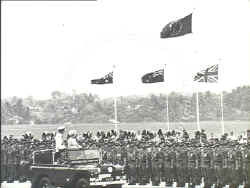 |
Singapore.
1972-03. The Royal Pennant tops the flags of
the three nations of the ANZUK Force, as Queen Elizabeth and Prince
Philip review a parade of the ANZUK Force during their one-day visit
to Singapore. Slouch-hatted Diggers from the 6th Battalion, The
Royal Australian Regiment (6RAR), are pictured being inspected by
the Royal couple. |
7,500 MEN AND WOMEN MADE
ANZUK
ANZUK Force was primarily
7,500 personnel from the three services of three nations serving in
Singapore, Malaysia, and on the high seas. The Force was supported by
about 4,750 locally employed civilians.
ANZUK was not large compared with the peak of the British presence in the
area of about 70,000 service personnel and civilians. On the other hand
our job was somewhat different. Stripped of diplomatic jargon ANZUK’s
main task was simply to be there. It was not to fight the CTs, nor was it
likely that we would be called on to fight any one else. Our governments
and the governments of Singapore and Malaysia considered that simply by
being here we would forestall the possibility of anyone upsetting the
political and military balance in the Malay Peninsula.
This would help the
governments of Singapore and Malaysia to get on with the job of developing
their economies, and building up their armed forces. Another task was to
work with the Singaporean and Malaysian Armed Forces to help them to
improve their expertise, but this was not their main role.
An aspect of ANZUK
which many people found difficult to understand was the fact that it is
not an international
organisation, like NATO, to which governments belong. ANZUK was merely a
shorthand name for the forces of Australia, New Zealand and the U.K.
which, for the sake of convenience, our three governments had decided to
place under the one commander, and to support through an integrated,
tri-national logistics organisation.
When ANZUK officially came into being on 1 November 1971 the first Force
Commander, Rear Admiral David Wells, RAN, had under command the following
major units:
-
Naval component:
-
two RN frigates,
-
RAN and RNZN frigates and an
-
RN or RAN submarine.
- 28th ANZUK Brigade:
- 6 RAR,
- 1 RNZIR, and
- 1 RHF,
- two field
batteries of artillery comprising 28th ANZUK Field Regiment,
- engineer
support in the form of 28th ANZUK Field Squadron,
- a squadron of light
helicopters, and
- a
- Air Force:
Unlike the other two services the air force
was mainly concentrated in Malaysia at Butterworth where Nos. 3 and 75
Squadrons RAAF (Mirages) and some RAAF Dakotas were based.
- A flight of
Mirages was regularly deployed to Tengah from Butterworth. Also at Tengah
were
- RAF Shackletons (soon to be replaced by Nimrods)
- Whirlwind (later
Wessex) helicopters of 103 Squadron RAF and Bristol freighters and
Iroquois helicopters of 41 Squadron RNZAF.
- ANZUK Support Group:
This formation comprised 24 integrated units providing all Army logistic
support requirements, and common support for all other services in
Singapore. Two ANZUK Bases were located at Woodlands and Sembawang to
cater for the support requirements of these areas.
- Force Units:
The main Force unit was
-
9 ANZUK Signal Regiment which provided internal
and external military communications.
-
ATMA, the ANZUK Traffic Management
Agency,
-
the ANZUK Intelligence and Security Unit, and
-
65 Ground Liaison
Section were also Force units.
The hallmark of ANZUK was integration. The only major units which were not
integrated were the three infantry battalions. 9 ANZUK Signal Regiment was
undoubtedly the most integrated unit with men and women from the nine
ANZUK services, Singaporean and Malaysian servicemen, and civilians in its
employ.
ANZUK Force could not have
existed without its large civilian component. In Singapore we employed one
civilian for every two servicemen and at Butterworth the ratio was almost
one for one. Most of the civilians were locally employed Singaporeans and
Malaysians doing a multitude of jobs ranging from the Installations
Auxiliary Police Force and technicians to clerks, typists, drivers, mess
staff and gardeners.
There was also an important
ex-patriate civilian element the Defence Administrative Office, and the
three national civilian administrative elements— the Australian Deputy
Assistant Secretary’s office, the New Zealand Administrative Support
Element, and the UK Joint Command Secretariat. These organizations dealt
mainly with the financial administration of the Force and national units
and the administration of the locally employed civilians.
And last, but not least, there were more than 10,000 dependants. In
Singapore married quarters were located in places as far flung as the
Naval Base in the north, the southern estates in the Pasir Panjang area,
and Changi in the east. At Butterworth families lived in the vicinity of
the base on the mainland, and on Penang Island. ANZUK service personnel
formed, without much doubt, the biggest expatriate community in Singapore
and our spending power, although vastly reduced from the heyday of the
British presence, was large enough to warrant mention in the Singapore
Government’s budget. Numerous schools, including two high schools, two
hospitals, medical centres and dental surgeries, two radio stations,
libraries, NAAFI shops, and extensive sporting facilities were provided to
support the ANZUK community.
EXERCISES AND
EXCURSIONS...
If you ask the question
"What did ANZUK achieve?", with reference to our primary
objective of promoting the "stability and confidence" of the
area, it is very hard to answer. All we can do is point to the fact that
over the three years of ANZUK’s existence Singapore and Malaysia
remained secure from outside military threats, and the economies of both
countries have continued to expand.
But if you ask the more
general question ~What did ANZUK do?’ there are a multitude of answers.
Firstly we did what all peace time armies, navies, and air forces do we
exercised. But here we often exercised somewhat differently. The navy and
the air forces often exercised with Singaporean and Malaysian forces. This
not only helped our allies to improve their military skills, but it
enabled us to get to know each other better. Of course the
"getting-to-know-you" process and the interchange of ideas was
even more noticeable among the forces of the three ANZUK nations as we
worked together almost every day. Also, ANZUK exercises were often planned
to include a lot of inter-service co-operation, and consequently the
standard of inter-service co-operation reached quite a high level.
It is not possible to list
all the exercises in which ANZUK units participated, but as the major
exercises represented the culmination of months of training on a smaller
scale the figures for major exercises give an indication of the wide
extent of the training programme. During the life of the Force ANZUK
assigned ships participated in 16 major "Five Power" exercises,
ground forces participated in 28, and (including IADS exercises) ANZUK
assigned aircraft also participated in 28.
But ANZUK was far from
being all work and no play, and most of us will remember what we did
off-duty far longer than the jungle bashing. Many ANZUK service personnel
and their wives worked quietly and generously for a variety of charitable
organizations. No one could calculate the value of the voluntary work, and
the gifts in cash and kind but it was considerable. Even the school
children made their contributions, the most novel being a "sponsored
silence for charity" during which members of the Chip Bee Youth Club
raised $45O~- by keeping quiet for 24 hours.
Many of us sampled the local culture. Tae kwon do flourished in the Base
Transport Unit, and untold numbers of wives learned Chinese cooking, mah-jong,
how to carve flowers out of vegetables or how to sew them from pieces of
Thai silk. Some took Malay classes.
Shopping excursions to
Transit Road, Changi village, Jalan Kayu or Holland village; eating
excursions at makan stalls, coffee houses, noisy Chinese restaurants and
plush hotels; holidays to the "Bali Hai" islands off Mersing,
Batu Ferringhi, or historic Malacca, day trips to Sentosa (or Blakan Mati
if you were here in the old days), the bird park, or a crocodile farm; new
friendships with people who spoke English with a funny accent (or people
who hardly spoke English at all).... These aspects of ANZUK were just as
important as the work we did. All of us who served with the Force have had
our lives enriched by the time we spent in Singapore and Malaysia.
THE END.......
When ANZUK was established
our Governments did not expect it to last forever. However the end came a
lot quicker than some of us had hoped and initially expected. The first
Force Commander, Rear Admiral Wells, had a task which must be unique: in
little over two years he first established the Force then, with the
establishment phase barely complete, he was directed to plan the run-down
phase which his successor, Air-Vice-Marshal Wakeford, was to execute.
The decision to disband
ANZUK, like the decision to establish it, was primarily due to an
election. In this case however the election was in Australia not the U.K.
When the new Australian Government set a ceiling of 600 Australian
servicemen in Singapore by 28 February 1974, and no more than 150 by April
1975 it was quite obvious that ANZUK could not continue to exist in its
original form. Many Australians were needed to keep the integrated
logistics systems functioning and without that there would not be much
point in having an integrated command.
So the New Zealand
Government established on 30 January 1974 NZ Force S.E. Asia which took
under command all the New Zealand units formerly part of ANZUK. The
British units remained under ANZUK, but preparations were put in hand for
Britain also to "go national". The integrated units which made
up the ANZUK Support Group were gradually disbanded during 1974 and
replaced by national units. ANZUK was visibly fading away.
On 16 December the Naval
and Air HQs disbanded and the ships and aircraft assigned to them
reverted to national command. 28 (UK) Inf Bde, which succeeded 28 ANZUK
Bde in January that year, came under national command on this date. |

